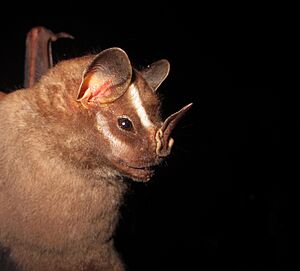Great stripe-faced bat facts for kids
Quick facts for kids Great stripe-faced bat |
|
|---|---|
 |
|
| Conservation status | |
| Scientific classification | |
| Genus: |
Vampyrodes
|
| Species: |
caraccioli
|
 |
|
The great stripe-faced bat (Vampyrodes caraccioli) is a type of bat. You can find it in areas from southern Mexico all the way down to Bolivia and northwestern Brazil. It also lives on the island of Trinidad. This bat mainly eats fruit. It is one of two species in its group, called Vampyrodes. The other species is Vampyrodes major.
Contents
Bat Basics: What is a Great Stripe-Faced Bat?
The great stripe-faced bat belongs to a larger family of bats called Phyllostomidae. Within this family, it is part of a group called Stenodermatinae. There are two types of bats in the Vampyrodes genus: Vampyrodes caraccioli and Vampyrodes major. For a long time, scientists thought Vampyrodes major was just a smaller version of Vampyrodes caraccioli. However, new studies of their bodies and DNA show they are actually different species.
Meet the Great Stripe-Faced Bat: Appearance
The great stripe-faced bat is a medium to large-sized bat. A grown-up bat usually weighs between 25.2 and 34 grams (about 0.9 to 1.2 ounces). Its forearm, which is like its wing bone, measures about 46.8 to 57.3 millimeters (about 1.8 to 2.3 inches) long.
This bat gets its name from the bright white stripes on its face. It also has a white stripe running down its back, from its head to its rear. Another special feature is its noseleaf. This is a unique part of its nose that is longer than it is wide.
Daily Life: Behavior and Feeding Habits
Great stripe-faced bats are nocturnal, meaning they are active at night. During the day, they rest in safe spots called roosts. When night comes, they fly out to find fruit and pollen to eat. They especially love bananas and figs.
These bats don't usually stay in the same roost every day. Female bats have been seen resting in groups of up to four. Male bats, however, often roost by themselves during the day. They like to make their day roosts in palm leaves, tree branches, and other leafy areas. Like many other bats in their group, female great stripe-faced bats usually have one baby at a time. They can also have babies more than once a year.
When a bat finds a good fruit, it will carry it to a special "feeding roost." This feeding roost is different from where they rest during the day. It's usually less than 100 meters (about 328 feet) away from the fruit tree.
Where They Live: Distribution and Habitat
The great stripe-faced bat lives in many different places because it can adapt to various environments. You can find them across Central and South America. This includes countries like eastern Colombia, eastern Ecuador, Peru, northern Bolivia, Venezuela, Trinidad and Tobago, French Guiana, Guyana, Suriname, and Brazil.
Even though they are found in many places, these bats can be hard to spot. They are considered a species of "least concern" by the IUCN. This means they are not currently in danger of disappearing.
Staying Safe: Predation and Threats
Great stripe-faced bats can be hunted by animals that hunt by sight. These predators often wait quietly and then pounce. Examples include owls and opossums.
Bats have learned to be careful. If the moon is very bright, they might stay in their day roosts instead of going out to feed. This is because bright moonlight makes them easier for predators to see.
Protecting the Species: Status and Conservation
The IUCN (International Union for Conservation of Nature) says the great stripe-faced bat is a species of "least concern." This is good news! It means they are not currently facing a high risk of extinction.
One reason for this status is that these bats can live in many different types of habitats. They are also spread out over a large area in Central and South America. Even though their numbers might be slowly going down in some places, it's not happening fast enough to put them in a threatened category.
However, great stripe-faced bats become less common in areas closer to the equator. Because of this, local governments should work to protect the populations of these bats that live in the southernmost parts of their range.


